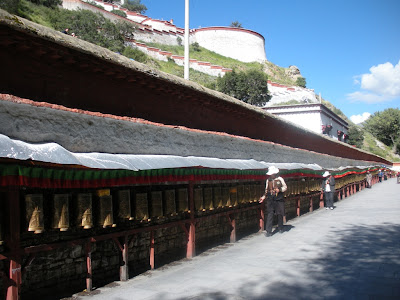Tuesday, September 27, 2011
Potala Palace
One of the first things we did in Lhasa was to see the famous Potala Palace up close & in person. I had pictured it being on a remote mountain top, difficult enough to reach so that pilgrims could feel they had accomplished something by getting there. Instead, it was smack dab in the center of town - the focus of attention as we rode down the main thoroughfare.
We climbed the stairs to the entrance & took a look out over the city. Across the street from the palace was a large concrete plaza with an obelisk stabbed into the middle of it. We later got a closer look at the monument & learned that it commemorates the founding of the People's Republic of China.
There were hundreds of pilgrims circling the palace, spinning their portable prayer wheels & chanting, some prostrating every few feet, looking as if they hadn't bathed since they started their journey to Lhasa from the countryside. Outside the palace there was a long line of fixed prayer wheels that the pilgrims spun as they passed.
The palace was decorated with colorful images of Tibetan gods, most of them fantastically monster-like. We were not permitted to take photos inside, but we were able to take some pictures of the painted walls just outside the entrance.
Inside it was dark & musty. Everything was brightly painted with a coating of smoke from the butter urns burning at various intervals inside the palace. Each pilgrim added a little bit of butter to each urn as an offering, ensuring the flame would continue to burn. Our guide told us that the fuel the pilgrims were using was actually vegetable-based since most people can't afford to give real yak butter.
Each pilgrim placed money in small bills in front of the butter urns, on the altars or between the slats separating them from the golden statues - in every nook & cranny available - bowing in prayer as they did so. The place was littered with money that would be used to make repairs to the palace, buy more Buddha statues & feed the monks living there.
Among the stashes of bills & coins, we saw hair clips, strings of beads & other every-day baubles - even grains of barley. Our guide explained that those who don't have money to offer the gods choose to offer what they do have, sacrificing what they can to ensure good fortune in the future.
Subscribe to:
Post Comments (Atom)







2 comments:
Holy cow, that place is huge! And what really colorful painting! So that is just a small sample of what was inside? Very cool!
I just added a photo album with lots more Tibetan art on Facebook. Check it out!
Post a Comment